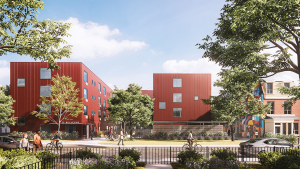Much has been written about Sidewalk Labs’ ambitious proposal to redevelop Toronto’s eastern waterfront. The futuristic plan, called Quayside, includes an entire neighbourhood of 10 mixed-used buildings up to 35 storeys, featuring Cross Laminated Timber (CLT) construction. The sheer scale of Quayside would place the development in the global forefront of mass timber projects.
The proposal has met resistance at various planning and political committee levels, focused largely on ethical issues surrounding the security and privacy of citizen data to be collected by Sidewalk Labs. However, that subject has not gained much public traction. A recent Forum Research study indicated that only 38 per cent of Torontonians were even familiar with the Quayside project and only 60 per cent of those expressed worries over Sidewalk Labs’ ability to collect data on area residents and workers.
However, what does seem to register is public concerns over mass timber’s fire resistance. In fact, it’s a topic that arises whenever wooden structures are considered in high density urban settings. The ability of mass timber to resist damage or load failure due to fire is not well understood.
Solid mass timber has proven its longevity, having framed the walls, floors and roofs of famous buildings all over the world for centuries. Mass timber today, however, is a manufactured product first developed in Europe in the 1990s. The term is often referred to as Cross Laminated Timber or CLT, and encompasses all manner of large-scale beams, truss systems or load-bearing panels. These structural members are made from several layers of kiln-dried lumber boards stacked in alternating directions and bonded with adhesives.
Mass timber gains its Flash Flame Resistance (FFR) rating by charring slightly during exposure to fire. This charring insulates the interior sections from further damage for a considerably long period of time. This differs significantly from highly-flammable, standard light timber framing that, by code, is shielded from flame by gypsum board.
“As the face of the timber panel is exposed to a fire that ramps up to a temperature in excess of 400 degrees C, the surface of the timber ignites and burns at a steady rate,” explains GreenSpec, a U.K. firm that advises industry professionals working with green building products. “As the timber burns, it loses its strength and becomes a black layer of ‘char’. The char becomes an insulating layer preventing an excessive rise in temperature within the unburnt core of the panel. It is this unaffected core which continues to function for the period of the fire resistance.” Each CLT panel used in the building must be designed to meet the fire resistance and load requirements assigned to that panel under the relevant building code.
Because CLTs are manufactured from several layers of material glued together, fire resistance is determined by the number and thickness of material layers, or plies, and the bonding adhesive used in production. The charring of the individual plies can be accurately predicted due to testing over the past several decades. The bonding adhesive, however, is a variable. New regulations are to be put in place in North America by 2021 that will result in higher standards for fire resistance in adhesives.
The overall fire resistance of CLTs is not only impressive, it retains structural stability under high temperatures better than steel. For example, tests conducted by the American Wood Council replicated five real-world scenarios using identical, furnished, one-bedroom apartments in a multi-storey building. The room built with five-ply CLT panels was subjected to temperatures exceeding 1,800 degrees Fahrenheit and reportedly survived three hours and six minutes, far more than the two-hour rating that building code required.
Mass timber construction has gained notice and popularity due to its long life and lower carbon impact. However, there needs to be more education concerning CLT’s fire resistance in order to quell the concerns of those who might live or work within the mass timber structures of the future.
John Bleasby is a Coldwater, Ont. based freelance writer. Send comments and Inside Innovation column ideas to editor@dailycommercialnews.com.








Recent Comments
comments for this post are closed